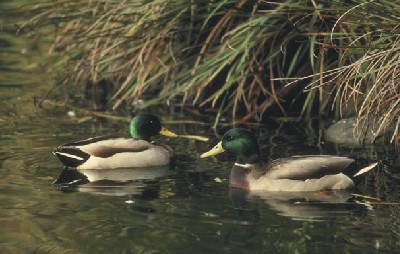home page
written by
Iliana Halakatevaki - Zafiroula Souvlaki
Christina Kotsifaki - Katerina Kidonaki
5th grade students
 Agia wetland represents a significant refuge, both for permanent and summer visitor birds, as they depend on it for food and shelter. So during wintertime one can observe many species of geese, ducks and swans. Nevertheless the nearby wastes, the uncontrollable grazing and illegal hunting pose a threat to the biotope. Analytically, the fauna of the wetland is as presented below.
Agia wetland represents a significant refuge, both for permanent and summer visitor birds, as they depend on it for food and shelter. So during wintertime one can observe many species of geese, ducks and swans. Nevertheless the nearby wastes, the uncontrollable grazing and illegal hunting pose a threat to the biotope. Analytically, the fauna of the wetland is as presented below. We can meet 3 species of carnivorous mammals, two rodents, one insectivorous and one lagomorph (the hair). The most representative mammal is the Cretan badger. Additionally, nano-bats, hedgehogs, hairs and weasels are observed in the surrounding area.
We can meet 3 species of carnivorous mammals, two rodents, one insectivorous and one lagomorph (the hair). The most representative mammal is the Cretan badger. Additionally, nano-bats, hedgehogs, hairs and weasels are observed in the surrounding area. All three amphibians that are seen in Crete can be met in the lake, the green toad (bufo viridis viridis), the forest toad and the bog toad. The green toad is a rather scarce species in the region. The buffalo frog appeared lately, which is becoming a threat for the other species. This peculiar frog must have escaped from a nearby illegal breeding farm. The stripe-necked terrapin (mauremis caspica), which is a threatened and protected by the European legislation species is very frequently met. These turtles need soft and not very wet soil to reproduce, but the appropriate soil is becoming scarce because of the expansion of cultivating land, waste disposing and the reed beds.
All three amphibians that are seen in Crete can be met in the lake, the green toad (bufo viridis viridis), the forest toad and the bog toad. The green toad is a rather scarce species in the region. The buffalo frog appeared lately, which is becoming a threat for the other species. This peculiar frog must have escaped from a nearby illegal breeding farm. The stripe-necked terrapin (mauremis caspica), which is a threatened and protected by the European legislation species is very frequently met. These turtles need soft and not very wet soil to reproduce, but the appropriate soil is becoming scarce because of the expansion of cultivating land, waste disposing and the reed beds.  Fourteen species of reptiles are recorded, to date. The most prominent is the whip snake (columber gemonensis gemonensis.
Fourteen species of reptiles are recorded, to date. The most prominent is the whip snake (columber gemonensis gemonensis. To date, 188 bird species have been recorded. From these, 45 nest in the biotope or in the surrounding area and depend on it for food. Fifty-nine species are protected by the Greek and European legislation, while 13 are characterized as high priority species. Moreover, forty-five are mentioned in the Red Book of Greece's threatened vertebrates. Little grebes (tachybatus ruficollis) are small birds that feed themselves in the waters and are present all year round.The biotope of Agia is the most important biotope for their reproduction in the whole region. The populations of wild ducks vary in size and species composition, throughout the seasons. From mid-autumn until early spring, one may distinguish up to 11 species, among them the globally threatened ferruginous duck (aythya nyroca). Nine heron species make their presence felt here. The most common are the grey heron (ardea cinerea), the squacco heron (ardeola ralloides), the little egret (egretta garzetta) and the purple heron (ardea purpurea). Other birds met are:
To date, 188 bird species have been recorded. From these, 45 nest in the biotope or in the surrounding area and depend on it for food. Fifty-nine species are protected by the Greek and European legislation, while 13 are characterized as high priority species. Moreover, forty-five are mentioned in the Red Book of Greece's threatened vertebrates. Little grebes (tachybatus ruficollis) are small birds that feed themselves in the waters and are present all year round.The biotope of Agia is the most important biotope for their reproduction in the whole region. The populations of wild ducks vary in size and species composition, throughout the seasons. From mid-autumn until early spring, one may distinguish up to 11 species, among them the globally threatened ferruginous duck (aythya nyroca). Nine heron species make their presence felt here. The most common are the grey heron (ardea cinerea), the squacco heron (ardeola ralloides), the little egret (egretta garzetta) and the purple heron (ardea purpurea). Other birds met are: v Glossy ibis (plegadis falcinellus)
v Glossy ibis (plegadis falcinellus)